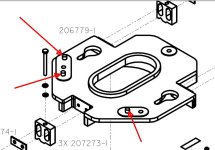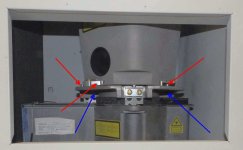Yes, the box with yellow labels.
It is mounted against 3 steel pins for proper alignment.
Before doing anything check if it is pushed against metal frame, or you have some thin spacer between. Like piece of film or something. It is important to preserve image geometry.
Pins marked RED.
Than you unscrew from the bottom 3 screws marked blue. Third one is on the back.
Than laser module fall down and can be removed.
When you put module back to the machine use that steel mins to put module in the same position it was originally.
Chris
It is mounted against 3 steel pins for proper alignment.
Before doing anything check if it is pushed against metal frame, or you have some thin spacer between. Like piece of film or something. It is important to preserve image geometry.
Pins marked RED.
Than you unscrew from the bottom 3 screws marked blue. Third one is on the back.
Than laser module fall down and can be removed.
When you put module back to the machine use that steel mins to put module in the same position it was originally.
Chris













